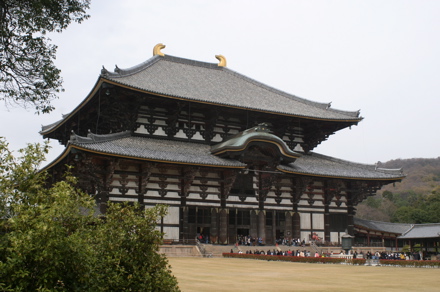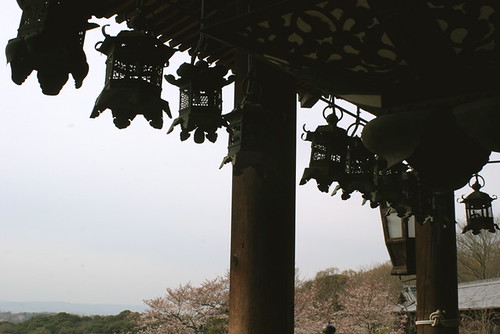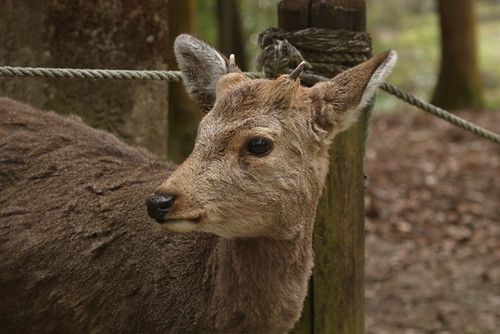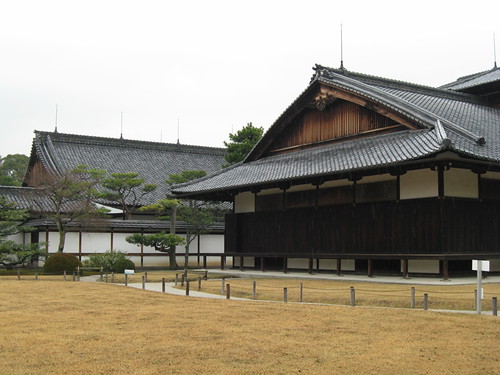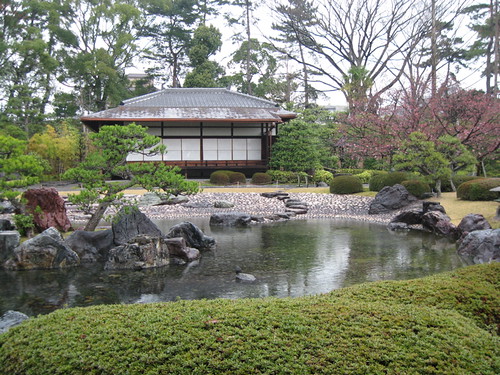Friday saw us back on the bullet train to Tokyo, where we arrived in the mid-afternoon. Read my Japanese fashion magazines on the train...well looked at the pictures, Japanese remains thus far incomprehensible, although we did start to recognise a few bits of lettering in Kyoto. Kyoto on the whole was much less well English-language-filled than Tokyo, although still enough English to find your way round.
We checked into our rather nice hotel back in Tokyo (Sunroute Plaza in Shinjuku), after navigating Shinjuku station yet again very unsuccessfully (Shinjuku station = nightmare). As the sun was due to start setting in an hour or so, we decided to walk a few blocks to the Tokyo Metropolitan Government Offices - an imposing, Gotham City style office complex in West Shinjuku.
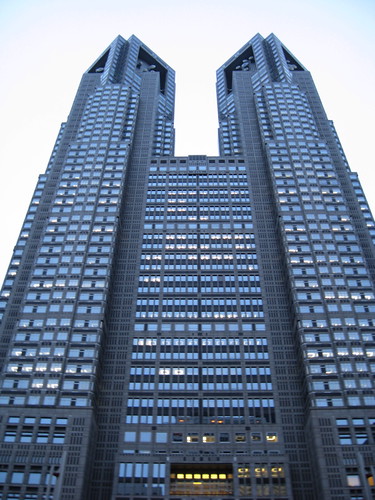
There is a viewing point at the top, which is free to go up to, so we went up and watched night fall and the lights of Tokyo start to twinkle.
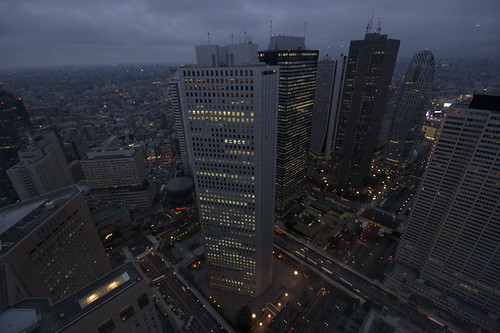
Retired to Harajuku after descending to find dinner. After trying to find one restaurant from the guidebook and then another, and failing on both, we were despairing that we'd end up with sushi again! I love sushi but not for every single meal. We were hesitating on going into the kaitensushi we'd been in the week before when we noticed an italian place underneath it so took a desperate chance. Fortunately it ended up pretty good, and was obviously pretty popular, very busy.
One thing I definitely found in Japan which is very different to the UK and even to Australia is that it's much harder to find bad food. Everywhere we randomly went into was at least above average. They seem to have pretty high standards of food preparation and have many more laws about hygiene (and a generally much higher standard) than what I am used to. You can even eat raw prawns safely in Japan (and I did try but it was eww slimy!), something I would never do here or in the UK.
Consequently, I was amazed to find that for the first time in the history of me going on holiday and eating out a lot, I had absolutely none of my usual belly trouble. Not a single moment. All the food we ate seemed so much fresher and lighter than what we are used to!
The day of travelling and several beers made us sleep well and we woke up on Saturday morning ready for a trip to the Tokyo National Museum, which is a bit like the Louvre of Japan, and sits up on one side of Ueno Park.
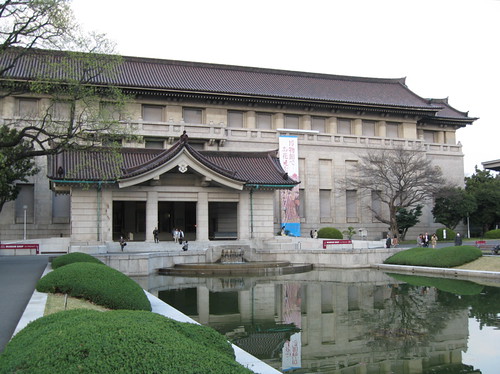
It is spread across several buildings and this is the main building with the main exhibitions. It was fascinating, as everything was so different. There were just some amazing things in there like nothing you see in the European equivalent museums. We spent the whole day there in the end, looking at 1000 year old painted screens and jewellry and samurai armour. We also had a surprisingly good lunch in the cafe - delicious steaming ramen with tempura prawns. They didn't have anything vegetarian but plenty with fish. I think if you are proper vegetarian in Tokyo it would be very very hard. Kyoto is much easier as their traditional cuisine is veggie and you could really just live on inari-sushi all day mmmmmm.
We headed back to Shinjuku for dinner and ended up in the Mango Tree thai restaurant in the mall! It was tasty as though. Plus also that meal may have begun my current cuttlefish obsession....
Sunday saw us on our way to Harajuku as it was cos-play day, the day when all the teenagers dress up crazy! We got there quite late but still saw some crazy dressed people. Lots of girls in the babydoll type outfits - dyed blonde hair, everything pink and frilly and white and carrying loads of soft toys and dolls around with them.
We had a good look round the shops. I loved La Foret, which was like an amazing big building of boutiques, even Topshop was there. In the basement there were lots of crazy stalls, with all the cos-play clothes and the people who worked in there were dressed in the clothes! Pirates and everything! I bought a jacket in Topshop (ahhhh), and then pootled up the road where we spent ages in Japanese toy shop Kiddyland (SO MANY TOTOROS!!) before back to sushi for dinner. The sushi hiatus didn't last!
Monday was a wet wet wet day. A perfect museum day, except that Monday is closing day in Tokyo for all that type of thing. We were up super early and went to Tsukiji fishmarket, the biggest fish market in the world (i think)? It's an odd place to go as a tourist, but really quite fun. There were HUGE fish (whole fish, like, bigger than me!) being pulled around on trailers on the back of these little motor trolleys and price tags sitting on top of boxes of huge crabs that were trying to crawl out! It was fun.
We then took the long trip back round to Ginza, a business/shopping district, where we ate a quick pizza for lunch and decided to stay in the shops for the rest of the day, which was a bit blah at first as we'd done our shopping the day before. However, we found the Tokyo branch of French department store Printemps, which was bizarre and good and they made all the announcements in French on the store intercom oddly so I actually understood something, although I'm not sure the Japanese shoppers did! Printemps had a lovely little cafe inside, where we had a wonderful cup of coffee (the Japanese simply cannot do coffee. It's for the most part quite vile) with the ladies who lunch.
After caffeining up, we explored the Sony centre, which was a cross between a shop and a showroom of all their latest technology, which you could play with! The had some very impressive things in there. We watched the 3D tv for quite some time! They also had a home-cinema set up where we relaxed for a bit!
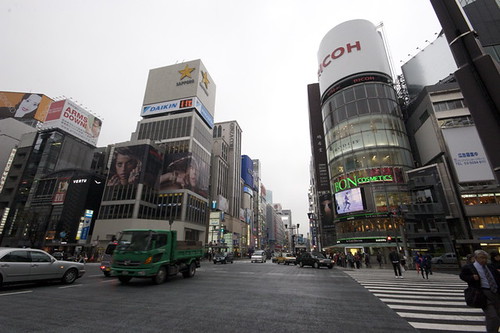
We also walked over supposedly the busiest crossing in the world, although it was quite quiet! Then we caught the train back to Harajuku and ate dinner in a pleasant pizza restaurant, before walking back to Shinjuku. When we got back, we were quite awake so decided to go have a look at night time Shinjuku, which is pretty much the image you get when you think of modern day Tokyo! It is crazy!
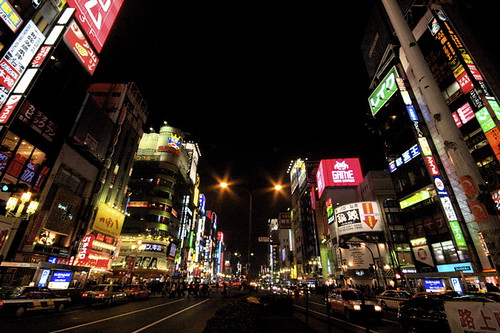
The main streets are awash with people and neon, games arcades, bars....the sidestreets filled with clubs and people waiting to meet other people, then as you head further in to the warren of streets the sleaze takes over and you are left with hostess bars, strip clubs and various unnamed venues, doorways hidden behind thick curtains...
After all that fun, we watched some amusing Japanese TV back at the hotel and got some sleep, ready for the last 3 days of our holiday.

